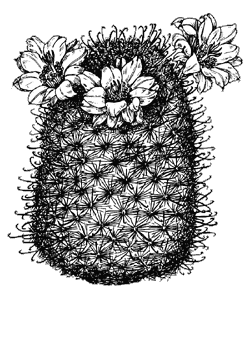Genus Mammillaria
English names: pincushion cactus, mammillaria, nipple cactus
Small, attractive, diverse, and generally easy to cultivate, mammillarias enjoy enormous popularity with collectors. Perhaps because of this, many minor geographical variants have been described as species—resulting in more than 400 named species. Thorough field work and genetic analysis often reveal that populations described as separate species actually belong to a single, variable species.
Description of Genus
Even after duplicate names are sorted out, Mammillaria is the largest of several genera of diminutive cacti with about 175 species worldwide. The Sonoran Desert species are less than 6 inches (15 cm) tall, with closely-spaced areoles bearing many spines that obscure the body of the plant. The areoles are at the tips of long tubercles that are arranged in 2 spirals (one clockwise, the other counterclockwise). These tuberculate stems contrast with the ribbed stems of the genus Echinocereus. In addition, many mammillarias have hooked central spines, whereas no hedgehog does. Plants range from single stems to large clusters, depending on species. Flowers, usually less than an inch (25 mm) in diameter and either pink or white, are produced in a ring near the tip of the stem.
Range
Various species grow from the lowest desert habitats to cold conifer forests and fairly wet tropical forests. The genus ranges from southern California to central Texas and southward through Central America. About 25 described species occur in the Sonoran Desert; some of these may be combined in the future.
Notes
The fruits of mammillarias are edible, though their small size makes them difficult to gather in nutritionally significant quantities. Some are pleasantly tart, others bland. The O’odham call them “coyote’s paws” to contrast them with the larger, juicy fruits of hedgehogs. (See Cucurbita digitata, coyote melon, for an explanation of “coyote” plants.)
Mammillarias often go through “boom-and-bust” population cycles. Mammillaria thornberi, for example, is so rare that it was considered for listing under the Endangered Species Act in the 1980s. But in the 1930s it occurred in countless millions in the Avra Valley west of Tucson. This vast population all but disappeared after the catastrophic freeze of 1937. The population has never recovered; no one knows why.
Mammillarias can be confused with plants of several other genera of small cacti such as Coryphantha, Epithelantha, and Neolloydia. Consult a field guide or taxonomic monograph to sort them out.
Mammillaria grahamii [M. microcarpa]
English names: fishhook pincushion, Arizona fishhook
Spanish name: cabeza de viejo(old man’s head)
Description
Single or clustered cylindrical stems grow to about 6 inches (15 cm) tall. The plant body is nearly concealed by dense, white, straight radial spines, in contrast to 1 to 3 central spines per areole, one of which is dark-colored and hooked. Crowns of bright pink flowers almost an inch (25 mm) across are borne just below the stem tips in early summer. The bright red, slightly fleshy fruits are presumably eaten by birds.
 |
Range
Fishhook pincushion occurs in Arizona south of the Mogollon Rim south into Sonora in desert and woodland habitats.
Notes
This is the most common mammillaria in Arizona Upland. It is especially abundant among debris under jumping cholla and partially concealed beneath desert shrubs such as bursage (Ambrosia deltoidea). Like many small desert plants, it cannot tolerate full sun.
The flowers can be used as a monsoon season rain gauge. The buds are produced during the preceding summer growing season and usually remain dormant through the winter, spring, and foresummer. The buds burst into bloom 5 days after the first rain of the summer and last about a week. Plants produce a second and sometimes a third flush of flowers after subsequent rains.











